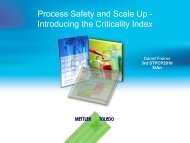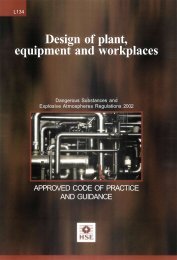Designing and operating safe chemical reaction processes HSG143
Designing and operating safe chemical reaction processes HSG143
Designing and operating safe chemical reaction processes HSG143
You also want an ePaper? Increase the reach of your titles
YUMPU automatically turns print PDFs into web optimized ePapers that Google loves.
Health <strong>and</strong> SafetyExecutive184 Other examples include:(a) increases in process temperature - these may accelerate an exothermic<strong>reaction</strong>, increase reactor vapour pressure, cause thermal decomposition,or simply reduce the time available for corrective action;(b) decreases in process temperature - these may cause unreacted material toaccumulate (this can be a particular problem in addition controlled semi-batch<strong>reaction</strong>s);(c) changes in raw material specification - these can introduce unexpected side<strong>reaction</strong>s;(d) concentration changes - these can change the rate of <strong>reaction</strong>;(e) increases in cycle process time - these may give a thermally unstable materialtime to decompose; <strong>and</strong>(f) replacement of metal pipes or piping components by plastic ones - staticelectricity may build up <strong>and</strong> ignite flammable materials.185 Make sure that you assess the effect of the modification on the original basisof <strong>safe</strong>ty. If the change affects the basis of <strong>safe</strong>ty then you should initiate a furtherassessment. All modifications should be fully documented.Operator training186 Adequate training <strong>and</strong> knowledge of the properties of the materials h<strong>and</strong>ledare essential for <strong>safe</strong> operations. Training is a requirement of the MHSWRegulations. 2 Carrying out the risk assessments required by these Regulationswill identify how much information, training <strong>and</strong> retraining is needed. An ApprovedCode of Practice 40 gives further guidance on these Regulations. HSE has produceda leaflet concerning training <strong>and</strong> identifying training needs. 41187 You need to inform all staff (including contractors, etc) who are on the site ofthe hazards of h<strong>and</strong>ling the materials involved, in <strong>operating</strong> the process, <strong>and</strong> theprecautions they need to take to ensure <strong>safe</strong>ty. Those directly responsible for theoperations should also receive specific training in emergency procedures. Periodicretraining will normally be required. The training should include the followingaspects:(a) the types of materials h<strong>and</strong>led, their properties <strong>and</strong> hazards;(b) general procedures for <strong>safe</strong> h<strong>and</strong>ling;(c) use of PPE <strong>and</strong> clothing;(d) the need for good housekeeping;(e) reporting procedures for faults <strong>and</strong> incidents, including minor leaks <strong>and</strong> spills;<strong>and</strong>(f) emergency procedures, including raising the alarm, calling the emergencyservices <strong>and</strong> the use of appropriate emergency equipment.<strong>Designing</strong> <strong>and</strong> <strong>operating</strong> <strong>safe</strong> <strong>chemical</strong> <strong>reaction</strong> <strong>processes</strong> Page 35 of 64










